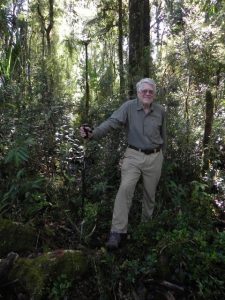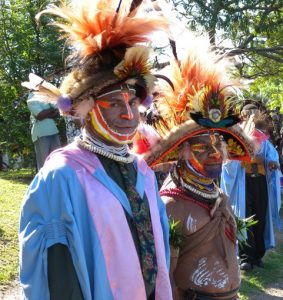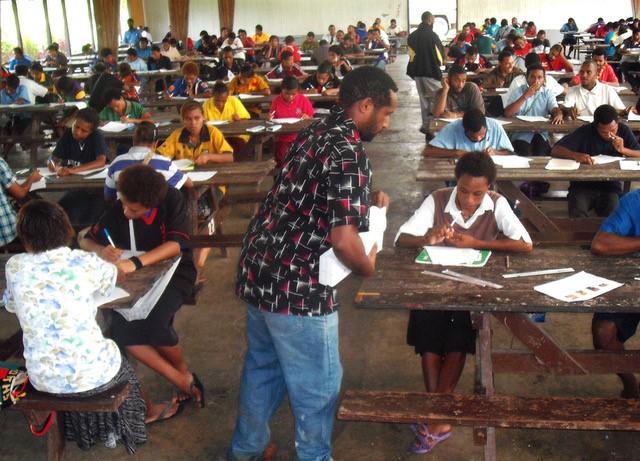Around the world, more than 7,000 languages are spoken, most of them by small populations of speakers in the tropics. Papua New Guinea (PNG), where nine million people speak 850 languages, is the most linguistically diverse place on Earth.
Unfortunately, a new study of secondary school students in PNG shows that the ability to speak Indigenous languages is declining precipitously in the younger generation. The study, published in the Proceedings of the National Academy of Sciences, was led by Alfred Kik, a postgraduate student from the Western Highlands of PNG, the first ever PNG researcher to lead a paper in the journal. Kik is a now a Ph.D. student, based in Europe at the University of South Bohemia.

UConn’s Robert Colwell, Distinguished Research Professor of Ecology and Evolutionary Biology and Emeritus Board of Trustees Distinguished Professor and a coauthor of the study, served as an international evaluator of Kik’s Master’s thesis at the University of PNG, the basis of the study. Colwell has worked in PNG on a research team led by Vojtech Novotny, senior author of the new study, a Czech entomologist with decades of experience working with local PNG naturalists.
Colwell has long had an interest in the geography of human languages, and has published previously on language geography with other researchers. The research team for the PNG study also included three other PNG postgraduate students, as well as linguists and social scientists from PNG, Europe, Australia, and USA.
“I’ve been involved with this group studying the geography of languages, because one of my specialties is biogeography, or the geography of life. I got involved in geography of languages as a geographical modeler of biodiversity, which is not the same by any means,” says Colwell. “However, it’s strangely coincidental that the most biodiverse places on earth, like Papua New Guinea, are also the most linguistically diverse places.”
Tok Pisin, an English-based language serving as PNG’s lingua franca, and English, the language of formal education, are replacing Indigenous languages. Kik and his collaborators tested more than 6,000 secondary school students from PNG speaking 392 languages. He found an unexpectedly rapid decline in their language skills. Only 58% of the students, compared to 91% of their parents, were fluent in Indigenous languages. This process is driven by an increasing share of mixed-language families, where each parent speaks a different Indigenous language, as well as life-style changes, particularly urbanization.
Declining language fluency is accompanied by loss of traditional skills including hunting, fishing, growing staple crops, house building from forest materials, and medicinal use of plants. The gradual loss of languages also leads to declining traditional knowledge of rainforest plants and animals.
The surveys in 30 secondary schools revealed these schools are a focus of extraordinary language diversity. As an extreme example, 381 students at the Lae Secondary School spoke 126 different PNG languages. Only one third of students speak the same Indigenous language as their best friend at school, suggesting that friendships are formed with low regard to the students’ language identity. This trend may also lead to further increase in mixed-language families in the future, accelerating the loss of languages.

“When people hear there are 800 languages in PNG, many think they’re probably closely related, but many of these languages aren’t even remotely related. Just for comparison, within all of Europe, there are spoken languages in only eight language families, and a single family, Indo-European, includes more than 94% of speakers in all of Europe,” says Colwell. “Now consider PNG, one-twentieth the area of Europe, which has spoken languages from some 30 language families.”
This diversity and the absence of any one dominant Indigenous language means that, if two Papua New Guineans were to meet at random, they would speak the same Indigenous language in only one out of 100 such encounters, making these languages too localized to be practical for wider communication.
Colwell adds, “A very large proportion of New Guinea people live on their own traditional land in their own language area. They grow crops, they use native plants from the extremely rich rain forests, many of medicinal or other cultural values. To know which plant to use in which situation is crucial knowledge. Knowing the names of useful plants and local birds in the language of their parents shows us whether these high school kids are maintaining not just language, but also traditional knowledge.”
This knowledge lives on through the Indigenous languages. Fortunately, a large majority (88%) of students want to teach Indigenous languages to their children, appreciating their cultural significance rather than practicality. While crucial for keeping languages alive, this intention faces powerful external pressures as key factors (education, cash economy, road networks, urbanization) associated with language decline are valued in contemporary society, in PNG and elsewhere.



